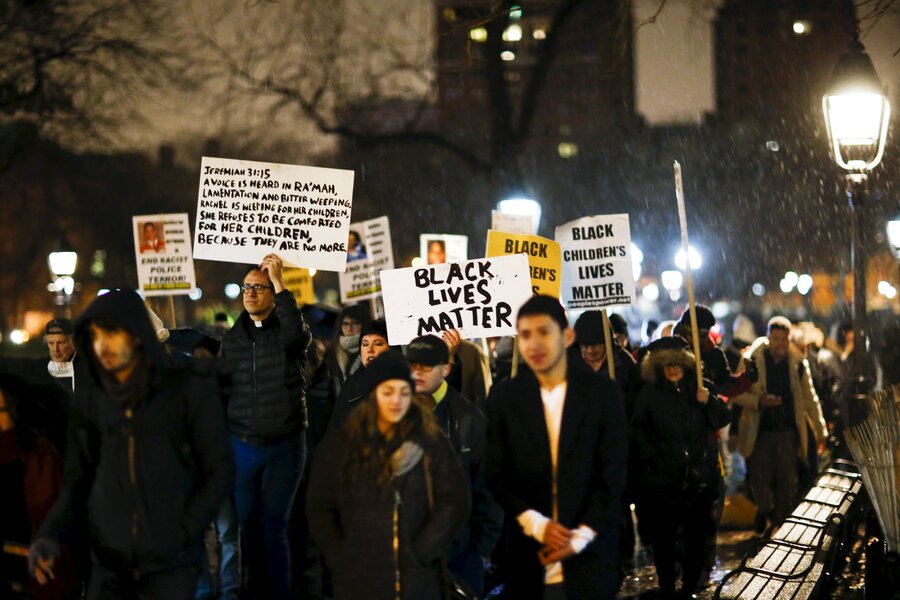Backlash against Tamir Rice shooting decision. Are grand jury reforms ahead?
Loading...
After the Cuyahoga County Prosecutor's Office announced on Monday that a grand jury did not indict the officer who fatally shot Tamir Rice, age 12, online backlash was immediate, reflecting deep divides over the fairness of the US justice system for African Americans.
"Tamir Rice was not on trial, but he might as well have been," the Huffington Post's Daniel Marans wrote, reflecting many observers' view that the boy's size and race fueled officers' decision to shoot him within two seconds of arriving at a park, where they were responding to a 911 call about a young man pointing a "probably fake" gun at others.
But the caller's doubt about the weapon − a realistic-looking plastic pellet gun — and note of Tamir's young age were not relayed to Cleveland Police Officer Timothy Loehmann or his partner, Officer Frank Garmback. According to police statements, Loehmann called for Tamir to put his hands up three times, but shot him from less than 10 feet when he saw Tamir reach for his waist. Officer Loehmann, who assumed the boy was about 20, feared he was reaching for the gun.
In June, a Cleveland Municipal Court Judge in an "advisory" role found probable cause to prosecute the officers, but County Prosecutor Timothy McGinty left the decision to a grand jury.
"The outcome will not cheer anyone, nor should it," Mr. McGinty said when announcing the jury's decision on Sunday. "Every time I think about this case, I cannot help but feel that the victim could have been my own son or grandson." But he said the jury had found Loehmann's decision reasonable, echoing reports the prosecutor has released throughout the hearing.
The third such report, released in November, described Tamir's death as
a tragic loss of life, but to compound the tragedy by labeling the officer's conduct as anything but objectively reasonable would also be a tragedy, albeit not carrying with it the consequences of the loss of life, only the possibility of loss of career.
Grand juries, which are required in many states to establish "probable cause" before charging a suspect with a serious crime, overwhelmingly choose to indict. In the past year, however, grand juries' failure to charge police officers in the deaths of Eric Garner and Michael Brown has bolstered movements such as Black Lives Matter, which allege that police are too rarely held accountable for the use of force, especially on black Americans.
Impassioned disagreements have divided those who see the case as textbook bias and others who say that although hindsight is 20/20, the decision to shoot was tragic but justified at the time, given the circumstances and perceived threat.
Where commentators differ is just where those relevant "circumstances" begin and end: should they include many white Americans' tendency to overestimate black boys' age by several years, and treat black children as less "innocent" than white peers? Should jurors consider that Tamir was warned his toy gun could cause problems? Many pointed out that Ohio is an open-carry state, where openly carrying a licensed firearm is not a crime. Others highlighted the fact that two police officers had been shot near the site of Tamir's death, while yet more, including three police experts, said the officer's "reasonable belief" that Tamir held a gun was enough to justify the shooting.
"The Supreme Court instructs to judge an officer by what he or she knew at the moment, not by what was learned later," said McGinty, who had recommended that the officers be cleared. "We are instructed to ask what a reasonable police officer, with the knowledge he had, would do in this particular situation."
Debate over the "reasonableness" of the shooting became so vitriolic that Cleveland.com editors chose to disable comments for all related news articles. "Rather than discuss the facts of the case, many commenters debased the conversation with racist invective," the publisher wrote on Nov. 30.
"It should never happen again, and the city has taken steps so it doesn't," McGinty said when announcing the jury's decision, citing the police department's moves to use more body cameras and dashboard cameras, as well as a Department of Justice investigation in 2014, which found that officers often relied on excessive force.
But some legislators and legal experts say that solutions also lie in reforming the grand jury system itself. In most cases, proceedings are kept out of sight to offer privacy and protect innocence, but some say the time has come to make them more transparent, and help Americans understand why only four police officers a year are indicted for gun-related deaths, when grand juries are typically led by the prosecutor to indict. Of 162,000 federal prosecutions in 2010, for example, grand juries chose not to bring charges in just 11 cases.
"I do think that we’re in an age when when transparency has triumphed over privacy ... and I have found that [Supreme Court Justice] Louis Brandeis’s dictum, that ‘sunlight is said to be the best of disinfectants,’ was right when Brandeis said it and is right today," Boston lawyer Harvey Silverglate told the Monitor earlier this month.
Wisconsin and New York have proposed reforms, such as making jury reports public and bringing in outside investigators. In mid-December, House Representative Hank Johnson, (D) of Georgia, made similar proposals in Congress for cases of fatal police shootings.






